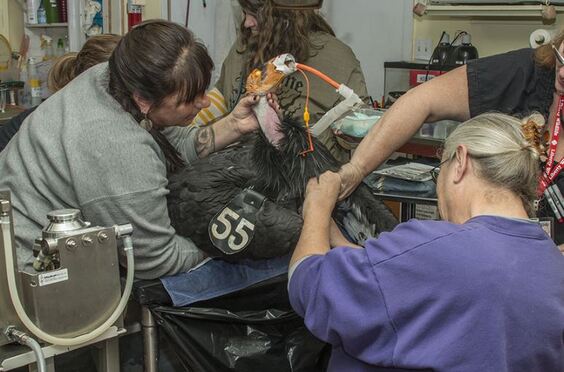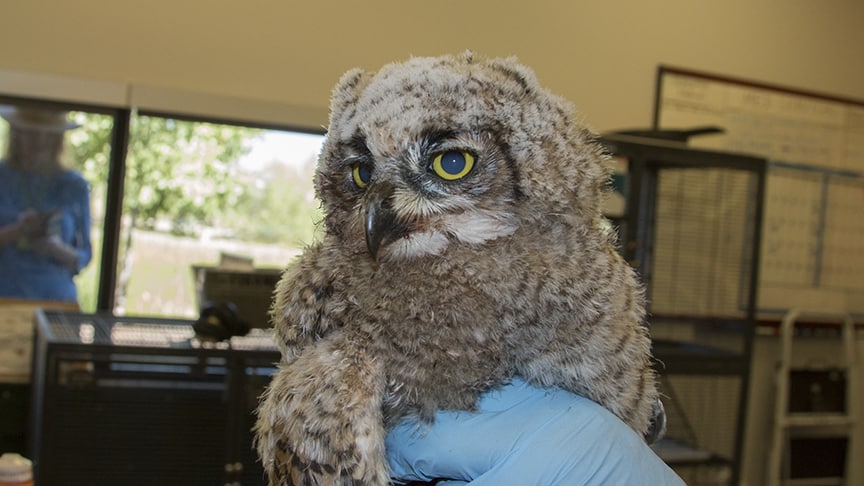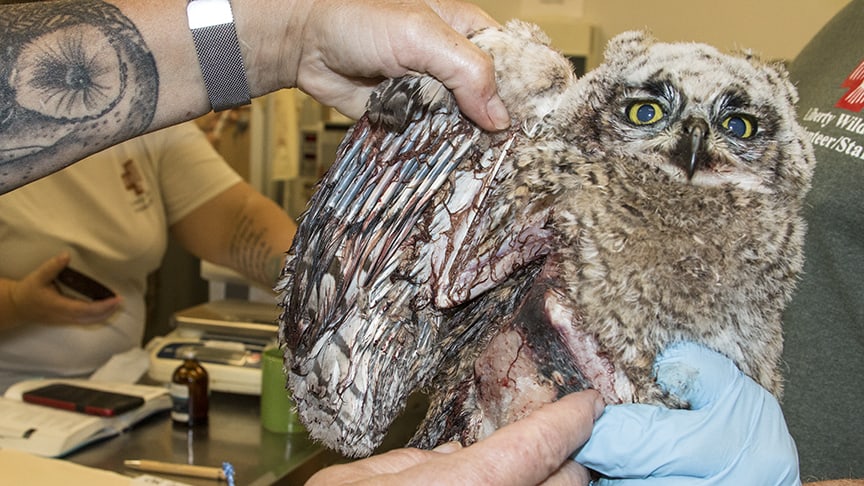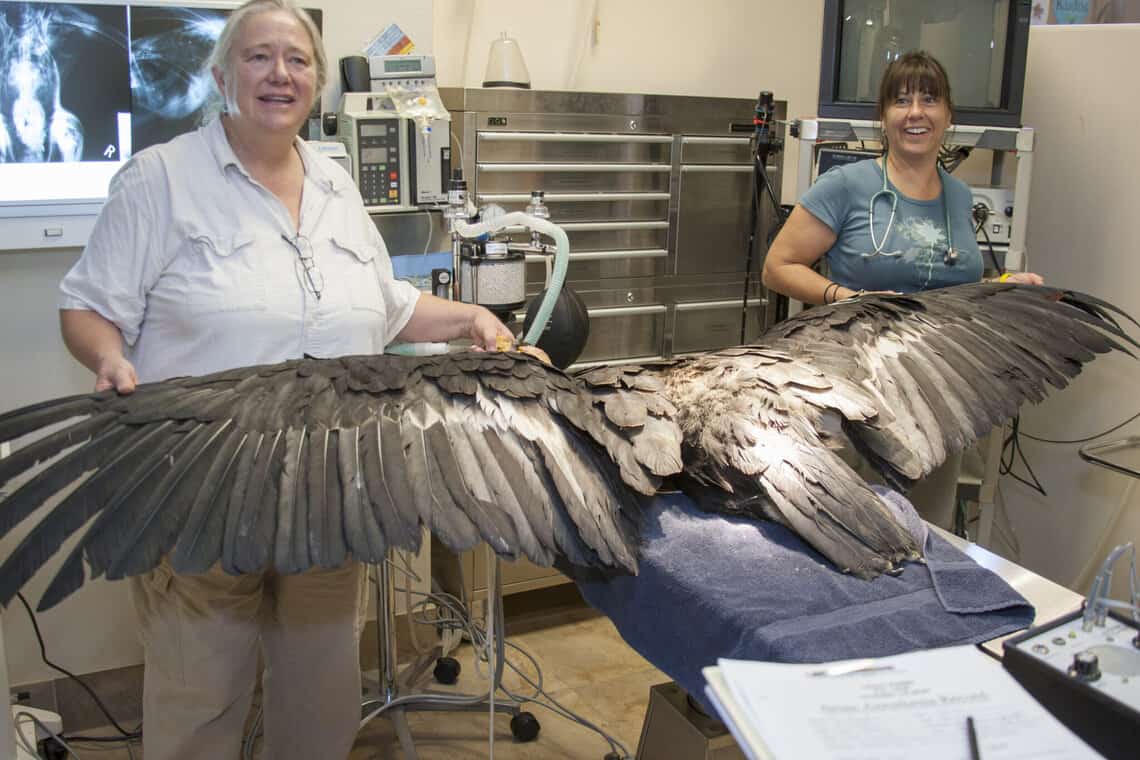By Megan Mosby, Executive Director, Liberty Wildlife
As if life wasn’t difficult enough for our feathered and winged neighbors, another layer of difficulties exists…difficulties in the form of environmental contaminants. In wildlife rehabilitation we see a yeoman’s number of human-caused problems including hit by cars, electric shock, cat or dog attack, and habitat destruction to name a few. Even if not intentional, these impacts are mostly preventable. However, some of the ugliest are those that are intentionally added to the environment, like contaminants resulting from second-hand impacts of lead bullets, as well as from rodenticide poisons designed to eliminate “pests”. The problem is that there are unintended consequences from both.
Liberty Wildlife is a non-profit organization based in Phoenix, AZ that is dedicated to wildlife rehabilitation, environmental education, and conservation services for the community. Avian species including raptors and hawks make up a large portion of the patients in need of rehabilitation. Possibly the most difficult unintended consequence to watch and treat is lead poisoning. Lead isn’t good for any living thing, including humans. Basically, it impacts the red blood cells which leads to kidney, liver, and neurological damage. In birds, the gastrointestinal tract, legs, and crops can become paralyzed. Even with a gorging bird, the crop will not allow food to be processed and the bird starves to death, with a full crop!

Lead ammunition for use in waterfowl hunting was banned in 1992 largely due to the impacts on human health and waterfowl population declines. However, it is still used commonly in other game hunting, as well as fishing equipment. Lead contaminates in a few ways. Lead bullets fragment in shot game and spread throughout the meat that people consume, causing health risks. Birds and other animals are poisoned when they scavenge on carcasses containing the bullet fragments. They also accidently ingest spent lead-shot pellets found commonly at hunting grounds, in gut piles, or consume lead-based fishing tackle lost in lakes, ponds, and rivers.
Sadly, it only takes a very small piece of lead to do severe or fatal damage to a bird as large as a California Condor. Lead poisoning was a major factor leading to the near extinction of California Condors and remains a major threat to their recovery. Condor biologists first discovered that lead was the culprit when they saw a condor die in the wild. They were able to retrieve its body to investigate its cause of death. They discovered that the bird died from lead poisoning. By putting two and two together they realized that the greatest condor mortality occurred during and right after hunting season. Hunters, using lead shot, inadvertently left gut piles after cleaning their kills. The condors, doing what condors do, were ingesting the leavings including the pieces of shattered lead. Adding to the problem, further studies revealed that lead contamination can be passed from the adult to the egg, and ultimately may lead to chick mortality.
A lead study done in house at Liberty Wildlife indicated that every raptor we tested over a 6-month period had some level of lead present in its blood… every hawk, vulture, and eagle. The levels weren’t all toxic, but lead was present in each of them. Liberty Wildlife has been the “go to” place for condors in Arizona suffering from debilitating amounts of lead toxicity, especially when crop stasis has begun. We treat these contaminated birds through chelation therapy, a process in which special drugs (in this case Calcium EDTA) are used to bind to metal (lead) in the blood. Once the drug has attached to the metal, the body removes it through excretion of waste. For the most part, it can be successful, but it can take weeks or months and is not without its own risks. We don’t know how many times a bird can be chelated without it having negative impacts or no impact at all.

Great efforts are being made by organizations like The Peregrine Fund to approach and educate the hunting community about the negative impacts of the use of lead ammunition. Switching to an alternative ammunition like copper or steel can make a huge difference in the ultimate health of the endangered California Condor population, as well as other birds.

From a rehabilitation standpoint, the other notable contaminant that is dealt with is rodenticide. There are many ethical problems with the use of rodenticides as they are slow and painful killers. The premise is that the animal ingesting the poison experiences a block to the vitamin K cycle. In other words, the blood no longer coagulates and the animal bleeds out. They experience lethargy, difficulty breathing, and a great deal of pain and discomfort for many days making them a perfect prey item for a dog, cat, or a prey-driven raptor. The predator unwittingly ingests the rodenticide and can suffer the same cruel and debilitating symptoms often leading to death. An owlet unknowingly fed a poisoned rat by its parents bleeds out slowly and dies without ever leaving the nest. The irony of the natural rat hunter falling prey to the rodenticide-poisoned rat isn’t easy to embrace. While many of these poisons have been banned in some forms or for personal use, they are still readily available for licensed pest control companies and agricultural settings.
Efforts to clean up the environment for wild birds needs to be an on-going effort. Rodenticides and lead should (or must) be eliminated whenever possible. To learn more about wildlife rehabilitation and our conservation work, please visit Liberty Wildlife.

